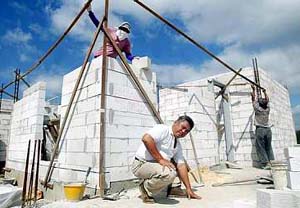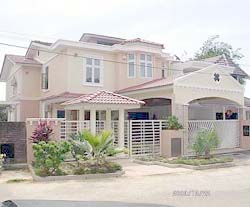Building homes that keep cool
naturally
The Star 15/2/2005
One housing developer is shying away from conventional
construction materials and methods in order to build homes which keep cool
naturally, thus using less energy, reports MICHELE LIAN.
IT IS just past two in the afternoon in Bukit Senggeh,
Malacca, but the unsheltered concrete slab beneath our feet feels only
slightly warm, as it would just before sunset.
We are at the building site of the Green Acres Orchard
and Farm Resort, where 12 single and double-storey holiday resort-style
houses are being constructed. The walls of the uncompleted bungalows are
also cool to the touch despite the searing heat.
“These walls are heat-resistant,” says Lincoln Lee,
executive director of Value Yield Sdn Bhd, the project developer. They
have been constructed using “autoclaved aerated” concrete bricks, which
have air bubbles to slow down the rate at which heat travels through them.
 |
|
Lincoln Lee says the ‘autoclaved aerated’ concrete
bricks he uses helps to keep houses cool.
|
Lee explains that heat travels in a straight line. So
the denser the material, the faster it will travel. The bubbles make the
bricks less dense.
The bricks are used along with old tyres, lightweight
plastic sheets and an ingenious ventilation system to build what Lee calls
Smart & Cool Homes. Together, these features work to keep the temperature
inside each house between 25 and 28°C.
“It is six to eight degrees cooler compared to the
temperature outside, whereas in most brick and mortar houses, it is two to
four degrees warmer than that,” says Lee.
To achieve this cooling effect, he incorporates the
various materials and methods into the structure of the house.
“It’s a complete system, from the foundation right up to
the roof. The envelope of the building is very important because heat
travels to cold spaces. As long as there’s cold, heat will travel.”
The foundation of the house is made of multiple layers
of tyres placed under plastic polypropylene sheets and wire mesh, which
are filled with concrete. Lee says the plastic makes the foundation
water-proof, so construction is unaffected by weather. This also renders
the house termite-proof, he claims.
“Tyres are fantastic absorbers of heat. At the Formula 1
races, the cars travel at about 360km per hour. When the driver jams on
the brakes, the friction generates heat of about several thousand degrees
Celsius, but the tyres don’t burn.
“When they are placed under the house, they prevent heat
from the ground from warming the house. And when the sun shines on them,
they absorb about 80% of the heat.”
Lee says he has no trouble sourcing for tyres because
motor repair workshops are more than happy to get rid of them. “Tyres are
not biodegradable and very expensive to recycle so disposing them is a
huge problem,” he adds.
And because the tyres are free, they help bring down
construction costs by about 20% for a terrace house and up to 30% for a
bungalow.
The houses in Green Acres comprise a built-up area of
between 1,653sqft and 1,790sqft and cost RM320,808 and RM338,808 for
single and double-storey units respectively.
Keeping cool
To prevent heat from coming in from the roof, Lee has
placed a ventilation gap in the roof to move hot air out and cold air in.
“Most houses have an attic temperature of about 50°C
because heat gets trapped there, but with this ventilation gap, it’s only
about 30°C.”
The cool interior of the houses makes them energy
efficient as air-conditioning will not be needed. This can easily shave
RM150 off the monthly electricity bill, says Lee, whose wife Lee Su May –
a physicist and energy management specialist – developed the Smart & Cool
Homes technology.
 |
|
This house in Malacca was renovated to incorporate
the Lees’ Smart & Cool technology.
|
He adds that the bill for each household should come to
RM40 to RM80 per month without air-conditioning, which translates to a
savings of 80% of the family’s energy usage.
To keep the houses at a constant temperature, Lee says
it is best that windows are kept closed during the day and left open at
night. “This ensures cool air goes in and stays there. And because the
‘thermal envelope’ is good, heat doesn’t seep in and build up during the
day.”
Another cost-effective feature of the Smart & Cool Homes
that also cuts down on resource wastage is the lack of formwork,
particularly those made of wood and steel, which support the house’s
structure. The upper floors are supported by corrugated beams which are
strong yet light, so up to 50% less steel, wood and concrete are used
compared to a conventional house.
Lee adds that the aerated bricks, which are also much
lighter but just as strong as regular bricks, are easier to handle, cut
and mend.
Combined, these features make the construction process
faster and less labour intensive. And because less conventional materials
are used, there is less trash at the building site. Some of the materials
Lee uses are sourced from other countries, but most are made here.
The houses are built using a modular construction method
which involves putting pre-cast pieces together much like the way one
would with a Lego construction set.
“It is easier to build compared to the conventional
method. In fact, building a Smart & Cool Home is idiot-proof. We need just
five workers who take about two months to build each house, whereas a
regular house would take about nine months and 20 workers to complete.”
Green living
Lee, 44, was only 20 years old when he took over his
late father’s construction business. As time went by, he realised major
flaws were being incorporated into Malaysian houses – the materials used
to build them trapped heat, making them unbearably hot to live in.
“Brick and mortar houses were introduced by Westerners
and the Chinese. Because they live in cold climates, they allowed the
house be heated up during the day.
“Bricks and concrete absorb heat and warm the house up
at night so they save on heating. But it doesn’t work in our climate. Even
so, we have been making this mistake for a long time.”
Lee wanted to build houses that were cooler inside and
reduce the wastage of construction material such as concrete, steel and
wood. He travelled extensively to learn how houses were built in other
countries. In Germany, he discovered the autoclaved aerated concrete
bricks.
After six years of research and experimentation to
determine which materials would serve best as the house’s ‘thermal
envelope’, Lee and his wife came up with their Smart & Cool Homes
technology.
To prove their technology was fact, not fiction, they
worked with researchers from Universiti Technologi Malaysia, who carried
out tests on three experimental homes in Kampung Chuah, Malacca – one
timber, the other brick and mortar, both of which were fitted with
air-conditioners, and a Smart & Cool home.
The verdict? The timber house was several degrees cooler
than its brick and mortar counterpart, but both were unbearable to live in
without air-conditioning.
“In a brick and mortar house, the temperature inside
remains as high as 33°C at 1am even though the outside ambient temperature
has dropped to as low as 26°C,” says Lee.
The Lees themselves will be moving into their own Smart
& Cool Home in Bandar Tasik Kesuma in Semenyih, Selangor, sometime this
year. Their home will serve as a model for their home-grown system.
To enhance its energy-efficiency, they plan to install
photovoltaic cells to run the house on solar energy. He estimates that it
will cost about RM25,000 to set up solar panels that will provide enough
energy to run an entire household.
Of the 12 units at Green Acres, eight have been sold.
“Our buyers are professionals aged between 38 and 58 years.”
Lee has licensed the Smart & Cool Homes system to other
developers, who plan to work on individual housing projects in Kuala
Lumpur.
“There is a demand for such houses in Kuala Lumpur
because the people there understand our concept and the need for such
houses.”
|